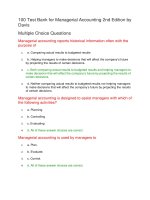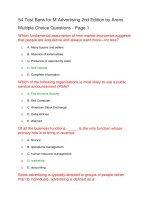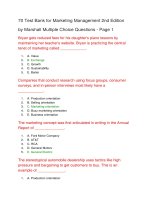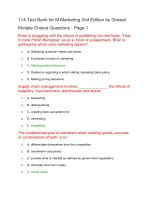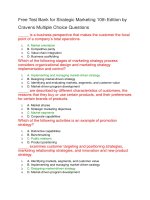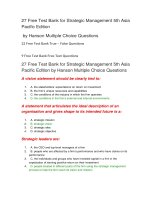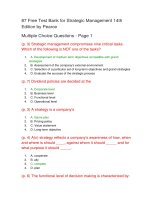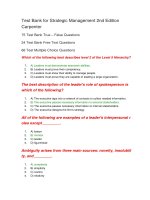131 test bank for strategic management 2nd edition by rothaermel
Bạn đang xem bản rút gọn của tài liệu. Xem và tải ngay bản đầy đủ của tài liệu tại đây (138.27 KB, 25 trang )
Test Bank for Strategic Management 2nd Edition by
Rothaermel
90 Test Bank Multiple Choice Questions
41 Test Bank Free Text Questions
True Cinemas Inc. and Digi Future Inc. are two companies that own and
run movie theaters in malls and other commercial areas. While True
Cinemas Inc. pursues a cost-leadership strategy, Digi Future Inc. adopts a
differentiation strategy. Which of the following statements is most likely
true of this scenario?
1.
True Cinemas will charge a premium price for its customers while Digi Future will
implement everyday low pricing.
2.
Digi Future and True Cinemas will not be direct competitors to each other and
their customer segments will overlap very little.
3.
Digi Future will keep its customer service at an acceptable level while True
Cinemas will provide superior customer service.
4.
True Cinemas and Digi Future will use a similar approach to create value for
customers by attempting to offer everything to everybody.
When a firm adopts a differentiation strategy to attain competitive
advantage, it focuses on:
1.
delivering unique features to its customers.
2.
providing the lowest prices to its customers.
3.
maximizing its profits by providing minimal customer service.
4.
lowering costs by employing low-skill employees.
Keeping in mind Apple's competitive advantage, which of the following
products was introduced by Apple in 2007?
1.
iPad
2.
iPhone
3.
iPod
4.
iTunes
Which of the following statements about strategy is NOT true?
1.
2.
Grandiose statements of desire, on their own, are not strategy.
Strategy is as much about deciding what not to do, as it is about deciding what to
do.
3.
Strategy is about creating superior value, while containing the cost to create it.
4.
Operational effectiveness and competitive benchmarking should be treated as
strategy.
TakeFlight Airways is a new entrant to the airline industry. While most of
its competitors are pursuing a cost-leadership strategy, TakeFlight
Airways has decided to execute a differentiation strategy. Which of the
following is the most likely implication of this decision?
1.
TakeFlight Airways will not gain a competitive advantage in the airline industry.
2.
TakeFlight Airways will gain a competitive advantage by reducing its prices.
3.
TakeFlight Airways will face low profit potential by pursuing a different strategy.
4.
TakeFlight Airways will create value for customers by delivering unique features.
Which of the following is an implication of all firms in an industry
pursuing a low-cost position through application of competitive
benchmarking?
1.
2.
3.
4.
No firm would face direct competition from others in the industry; hence, profit
potential would be high.
Each firm would be catering to a different customer segment.
The firms would eventually have no resources to invest in product and process
improvements.
Each firm would be in a better position to gain a competitive advantage.
Through _____, a firm puts its guiding policy into practice by employing a
set of coherent actions.
1.
strategy control
2.
strategy implementation
3.
strategy formulation
4.
strategy analysis
New Communications Inc. is a newspaper publishing company whose
average return on invested capital is approximately 5 percent. Because
newspaper publishing is a declining industry, the industry average has
been negative (-5 percent) for the last few years. In this scenario, New
Communications Inc. has a _____.
1.
competitive advantage
2.
balanced scorecard
3.
competitive disadvantage
4.
power position
In _____, a firm frames a guiding policy to address the competitive
challenge.
1.
strategy control
2.
strategy implementation
3.
strategy formulation
4.
strategy analysis
Underperformance relative to other firms in the same industry or the
industry average results in a(n) _____ for a firm.
1.
sustainable competitive advantage
2.
increased power distance
3.
diseconomies of scope
4.
competitive disadvantage
Which of the following scenarios illustrates a firm that has a sustainable
competitive advantage?
1.
Newon Inc. generated a revenue of $300,000 this financial year, which is close to
the industrial revenue average of $320,000.
2.
SM Inc. almost doubled its sales to 8500 units this year compared to its previous
year's sales of 5000 units, though the industry average is 10,000 units.
3.
TrueLink Corp. was able to hold its market share of 68 percent in the social
networking industry for more than three years.
4.
Max Electrova Inc. was able to outperform its competitors with its new production
system, in terms of revenue, for a brief period of four months.
A firm that achieves superior performance relative to other firms in the
same industry or the industry average has a(n) _____.
1.
competitive advantage
2.
balanced scorecard
3.
power position
4.
equity leverage
Which of the following stages of the strategic management process
involves an evaluation of a firm's external and internal environments?
1.
Strategy analysis
2.
Strategy implementation
3.
Strategy formulation
4.
Strategy control
If SA Pharmaceuticals obtains an 18 percent return on invested capital,
which of the following will help determine if it has a competitive advantage
over other pharmaceutical companies?
1.
Comparing the return to the return on invested capital obtained by other firms in
the industry
2.
3.
4.
Assessing the value based on the shareholders' expectations of return on their
capital
Evaluating the liquidity ratios for other pharmaceutical companies
Comparing the value to the history of the firm's return of investment over a number
of years
_____ is best described as an integrative management field that combines
analysis, formulation, and implementation in the quest for competitive
advantage.
1.
Supply chain management
2.
Integrated technology management
3.
Strategic management
4.
Inventory management
Exis Inc. and Stelma Inc. are two companies that have been manufacturing
typewriters for almost 30 years. Due to the reduced demand for
typewriters today, both companies' average return on invested capital is
approximately -5 percent. The current industry average is 2 percent. In
this scenario, Exis Inc. and Stelma Inc. most likely have:
1.
competitive advantage over other firms in their industry.
2.
competitive parity with each other.
3.
strategic alliance with each other.
4.
economies of scope instead of economies of scale.
For a firm that operates in an industry where competition is high, which of
the following practices will result in inferior performance?
1.
Choosing a distinct but different strategic position in the industry
2.
Working toward increasing the difference between value creation and cost
3.
Trying to be everything to everybody by combining different competitive strategies
4.
Focusing on creating value for customers rather than destroying rivals
Which of the following forces is most closely related to industry effects
within the automobile industry?
1.
2.
The actions taken to improve employee productivity within a firm
The human resource strategy managers adopt to acquire the best talent from the
industry
3.
The types of products and the services offered within the industry
4.
The decisions made within a firm regarding pricing of a product in the market
FindFor Inc. is an e-commerce retail firm that sells a variety of
merchandise online. Through services like cash on delivery, easy return,
and online tracking, the company has created more customer value than
its competitors (brick-and-mortar businesses) at the same price. Also, the
company's costs are substantially low due to minimal investment in
operation and administration. In this scenario, FindFor Inc. has most likely
been able to provide superior value and cost control through _____.
1.
strategic parity
2.
strategic profiling
3.
strategic liquidation
4.
strategic positioning
The average cost of production for a bottle of vitamin water in the industry
is $4 while its average price is $7. StoreAll Inc. manufactures the same
product for $3 per bottle and sells it for $7 per bottle. Which of the
following statements is most likely true of StoreAll Inc. in this scenario?
1.
It has a competitive advantage in the industry.
2.
It has a competitive disadvantage in the industry.
3.
It has competitive parity with other firms in the industry.
4.
It has formed a strategic alliance with other firms in the industry.
Industry effects describe the underlying _____ structure of the industry.
1.
demographic
2.
economic
3.
psychographic
4.
ethnographic
Which of the following forces tends to be more important in determining a
firm's performance?
1.
The underlying economic structure
2.
The entry barriers in the industry
3.
The actions of managers within the firm
4.
The number and size of other firms in the industry
A company wants to determine how industry effects have affected its
profitability. Which of the following elements should the company focus
on?
1.
The barriers to entry and exit within the industry
2.
The pricing method opted by the managers to face competition within the industry
3.
The brand strategy the managers adopt to establish the firm in the industry
4.
The strategic position the firm pursues within the industry
If a company wants to gain a competitive advantage in a highly
competitive industry, it should ideally:
1.
execute an integrated cost-leadership and differentiation position.
2.
copy the strategies of other firms through competitive benchmarking.
3.
provide goods or services similar to its competitors' at higher prices.
4.
stake out a unique position within the industry.
Pink Couture Inc. and Pink Blush Inc. are two companies in the apparel
industry. While Pink Couture Inc. focuses on providing unique product
features and superior customer service, Pink Blush Inc. focuses on low
prices and minimal customer service. Both companies have been able to
gain a competitive advantage. This is most likely because:
1.
the companies have executed integrated strategies.
2.
the companies have entered into a cartel arrangement.
3.
the companies have pursued distinct strategic positions.
4.
the companies have engaged in direct imitation and substitution.
Which of the following factors most effectively contributed to the success
of JetBlue airlines in comparison to other airlines like Delta, United, or
American?
1.
Its point-to-point business model
2.
Its reliance on outsourcing
3.
Its hub-and-spoke system
4.
Its shorter distances
Which of the following statements should ideally reflect a firm's strategy
for competitive advantage?
1.
Our strategy is to win at any cost.
2.
We will be number one in the industry.
3.
Our aim is to create superior customer value while controlling costs.
4.
We want to be the market leader by exactly replicating our competitor's strategy.
A firm is said to gain a competitive advantage when it can:
1.
exceed its own previous performances.
2.
provide products similar to its competitors, but at lower prices.
3.
perform at the same level as that of its competitors.
4.
minimize the difference between value creation and cost.
Which of the following statements accurately describes firm effects?
1.
2.
They attribute firm performance to the industry in which the firm competes.
They attribute firm performance to the actions managers take within a chosen
industry.
3.
They refer to the value-creation potential of a large, diversified enterprise.
4.
They refer to the external circumstances surrounding all the firms in an industry.
_____ is best described as a set of goal-directed actions a firm takes to
gain and sustain superior performance relative to competitors.
1.
Behavior modification
2.
Strategy
3.
Credo
4.
Competency management
90 Free Test Bank for Strategic Management 2nd
Edition by Rothaermel Multiple Choice Questions Page 2
Which of the following scenarios best illustrates a good stakeholder
strategy?
1.
VP Inc. follows a strategy in which maximization of the shareholders wealth is the
primary concern of the managers.
2.
Carrvero Inc. ensures that its employees are paid the least in the industry so that
its external stakeholders can get the best price.
3.
PA Corp. distributes only 70 percent of its annual profit after tax to shareholders,
while the remaining is distributed among employees and the local community, and
invested for further research.
4.
Gen Pharma Corp. ensures that it fully exploits free natural resources, so that
most of its profits go to shareholders in the form of dividends.
_____ provides a decision tool that enables a firm to act as a good
corporate citizen by allowing its managers to recognize, prioritize, and
address the needs of different groups of individuals who take personal
interest in the firm's performance and survival.
1.
Strategy analysis
2.
Stakeholder impact analysis
3.
The SWOT analysis
4.
Strategic positioning
The past black swan events in the United States demonstrate that:
1.
managerial actions can affect the economic well-being of large numbers of people
around the globe.
2.
decisions and strategies implemented within a firm will only affect the firm and not
the entire industry.
3.
corporate governance is unnecessary as firms are becoming socially responsible.
4.
industry effects are more important than firm effects in determining firm
performance.
Which of the following is NOT a stakeholder attribute that managers
consider during stakeholder impact analysis?
1.
A stakeholder's power
2.
A stakeholder's legitimate claim
3.
A stakeholder's urgent claim
4.
A stakeholder's liquidity
As the legal owners, _____ have the most legitimate claim on a company's
profits.
1.
creditors
2.
employees
3.
shareholders
4.
board members
Which of the following is NOT an example of a software company's
external stakeholder?
1.
Creditors
2.
Customers
3.
Alliance partners
4.
Project managers
Which of the following best qualifies as a firm's internal stakeholder?
1.
An auditor assigned to the firm by a federal government agency
2.
A labor union with whom the firm's employees can affiliate
3.
A manager taking care of the firm's operations in a foreign market
4.
A competitor manufacturing the same products as that of the firm
The interaction between a firm and its diverse internal and external
stakeholders is best described as a(n):
1.
ergonomic relationship.
2.
cartel arrangement.
3.
exchange relationship.
4.
fiduciary responsibility.
Which of the following was a key driver in the Occupy movement of 2011?
1.
The need for a capitalist economic system
2.
The issue of income disparity
3.
The need to reduce government intervention in businesses
4.
The issue related to dumping of cheap foreign products
_____ are incidents that describe highly improbable but high impact
events.
1.
Miracle events
2.
Wild card events
3.
Black swan events
4.
Fat tail risk events
Stakeholder strategy is an integrative approach to managing a diverse set
of stakeholders effectively in order to _____.
1.
single-mindedly focus on the stockholders alone
2.
gain and sustain competitive advantage
3.
minimize the joint value created
4.
minimize the difference between value creation and cost
Pure Food Inc., a multinational company, relies on its media partner Radio
Ex to regularly advertise its offers, sales, and new products. Radio Ex is
invested in this relationship because it generates most of its revenue from
advertising Pure Food's products. In this scenario, Radio Ex is Pure Food
Inc.'s _____.
1.
stockholder
2.
workforce
3.
internal stakeholder
4.
external stakeholder
Stakeholder impact analysis primarily helps a firm:
1.
gain a competitive advantage while acting as a good corporate citizen.
2.
lower the difference between its value creation and costs.
3.
single-mindedly focus on shareholders alone.
4.
exploit external stakeholders to benefit internal stakeholders.
The first step in stakeholder impact analysis involves:
1.
2.
formulating a stakeholder strategy to balance the different needs of various
stakeholders.
identifying the opportunities and threats the stakeholders present.
3.
describing the economic, legal, ethical, and philanthropic responsibilities of the
firm toward the society.
4.
identifying the stakeholders that currently have, or potentially can have, a material
effect on a company.
In a firm, a strategist's job should be to:
1.
limit the participation of external stakeholders—customers and suppliers—in value
creation.
2.
isolate the firm's internal stakeholders from its external stakeholders.
3.
focus solely, in a single-minded manner, on maximizing shareholder wealth.
4.
understand the complex web of exchange relationships among different
stakeholders.
Rachel owns a large portion of GM Cube Inc.'s stocks. However, she is not
employed by the company. In this scenario, Rachel is the company's
_____.
1.
external stakeholder
2.
internal stakeholder
3.
creditor
4.
customer
Which of the following is an example of a firm's external stakeholder?
1.
Employees
2.
Customers
3.
Shareholders
4.
Board members
Shortly after the small island of Balamia experienced multiple unexpected
high-intensity earthquakes that caused massive destruction, many banks
and insurance companies filed for bankruptcy. This left the economy of
the country in a poor state. The natural calamity in Balamia best
exemplifies _____.
1.
a black swan event
2.
a wild card event
3.
skewness risk
4.
kurtosis risk
The best example of a firm's external stakeholder is a(n):
1.
government agency that regulates the prices of products manufactured by the
firm.
2.
board member from a wholly owned foreign subsidiary of the firm.
3.
shareholder who has invested money in the firm but is not employed by the firm.
4.
employee of the firm who is responsible for a contract project.
Sun Inc., a vendor, regularly supplies pallets to Octangle Corp. for its
shipping business. Therefore, Sun Inc. is Octangle Corp.'s _____.
1.
internal stakeholder
2.
stockholder
3.
shareholder
4.
external stakeholder
A core tenet of stakeholder strategy is that a:
1.
firm should isolate its internal stakeholders from its external stakeholders.
2.
single-minded focus on shareholders alone exposes a firm to undue risks that can
threaten the very survival of the enterprise.
3.
multifaceted exchange relationship with internal and external stakeholders can
lead to a firm's competitive disadvantage.
4.
firm should work toward competitive parity rather than gaining and sustaining a
competitive advantage.
Due to several black swan events in the past, the:
1.
shareholders of public companies have become more confident in investing their
resources in businesses.
2.
need for corporate governance and transparency has reduced within various
industries.
3.
nations around the globe have explicitly appreciated and accepted capitalism as
an economic system.
4.
implicit trust relationship between the corporate world and society at large has
deteriorated.
After a firm has identified its key stakeholders in stakeholder impact
analysis, the immediate next step is to:
1.
recognize the opportunities and threats the stakeholders present.
2.
identify stakeholders' interests and claims.
3.
formulate a stakeholder strategy.
4.
address the stakeholders' concerns.
In the United States, which of the following was born out of dissatisfaction
with the capitalist system in 2011?
1.
The Sarbanes-Oxley Act
2.
The Occupy movement
3.
The Tea Party movement
4.
The Taft-Hartley Act
Derek, a retired CEO, invests capital in a start-up company that creates
mobile applications. He mentors the entrepreneur and the employees of
the company because he wants the company to perform well and survive
in the market. Thus, Derek is the start-up company's _____.
1.
headhunter
2.
category captain
3.
employee
4.
stakeholder
When the strong dictatorial rule in Canria unexpectedly collapsed due to
the shocking mass murder of the royal family, the nation's economy
experienced drastic changes. The laws became more restrictive, the
country lost many locally produced resources and products, and the
distribution of wealth became inequitable. The unexpected event that led
to these changes can best be described as a(n) _____ event.
1.
extinction
2.
wild card
3.
black swan
4.
miracle
Which of the following groups is considered to be the primary stakeholder
for public-stock companies?
1.
Suppliers of capital
2.
Employees
3.
Suppliers
4.
Potential customers
State-level government agencies that check whether firms are meeting
statutory safety measures in their production units are considered to be
the firms' _____.
1.
stockholders
2.
shareholders
3.
internal stakeholders
4.
external stakeholders
A firm's stakeholder strategy primarily allows the firm to:
1.
analyze and manage how various external and internal stakeholders interact to
jointly create and trade value.
2.
effectively isolate its internal stakeholders (like shareholders and employees) from
its external stakeholders (like customers and media).
3.
transfer the contributions external stakeholders make into benefits for the internal
stakeholders.
4.
facilitate the development of a competitive relationship between its internal and
external stakeholders.
90 Free Test Bank for Strategic Management 2nd
Edition by Rothaermel Multiple Choice Questions Page 3
The management of Five Square Corp. wants to reduce the separation
between ownership (by shareholders) and control of the firm (by
professional managers). Which of the following practices would best help
the company do this?
1.
Allowing employees to purchase the stock of the company at a discounted rate
2.
Reinvesting the annual profits of the company into research and development
3.
Issuing new additional shares to the existing stockholders in proportion to their
current holdings
4.
Declaring the annual profits as bonus dividends to the existing stockholders
_____ is best described as a framework that helps firms recognize and
address the economic, legal, social, and philanthropic expectations that
society has of the business enterprise at a given point in time.
1.
Corporate social responsibility
2.
Integrated social network
3.
Strategic positioning
4.
Strategy formulation
Which of the following stages in the AFI strategy framework involves
designing a business, corporate, and global strategy?
1.
Strategy control
2.
Strategy implementation
3.
Strategy analysis
4.
Strategy formulation
Paying taxes to local government authorities from the annual revenues
generated by a firm represents the firm's _____.
1.
philanthropic responsibilities
2.
economic responsibilities
3.
psychographic responsibilities
4.
political responsibilities
A firm's economic responsibilities are primarily directed toward:
1.
minimizing shareholders' wealth.
2.
acting as a good corporate citizen.
3.
doing what is right, just, and fair.
4.
gaining and sustaining competitive advantage.
Which of the following statements is true of the social responsibilities of a
business?
1.
A firm's ethical responsibilities go beyond its legal responsibilities.
2.
Shareholders mandatorily require a firm to perform its ethical and philanthropic
responsibilities.
3.
Ethical responsibilities are the foundational building block of a firm's social
responsibility.
4.
Legal responsibilities are often subsumed under the idea of corporate citizenship,
reflecting the notion of voluntarily giving back to society.
Which of following practices of a firm satisfies its ethical responsibilities?
1.
Using plastic as the packaging material though it is harmful to the environment, yet
legal
2.
Outsourcing production to a less developed country and paying wages that are
below its own country's accepted minimum wages
3.
Using advertising and other forms of promotion to endorse luxurious lifestyles
4.
Selling vaccines at a subsidized price in a less developed country even though
this results in reduced shareholder returns
Cocoa Noir Inc., a company that manufactures chocolates, incurs higher
costs because of its refusal to import cocoa beans from countries where
child labor is prevalent. This reflects Cocoa Noir's _____ responsibility.
1.
economic
2.
legal
3.
ethical
4.
demographic
In the pyramid of corporate social responsibility, _____ are the
foundational building block.
1.
economic responsibilities
2.
ethical responsibilities
3.
philanthropic responsibilities
4.
legal responsibilities
In the final step of the stakeholder impact analysis, a firm:
1.
identifies its stakeholders' interests and claims.
2.
differentiates its internal stakeholders from its external stakeholders.
3.
recognizes the opportunities and threats stakeholders present.
4.
decides a course of action to address the stakeholders' concerns.
Which of the following statements accurately describes corporate social
responsibility (CSR)?
1.
2.
CSR promotes the view that companies should single-mindedly focus on
shareholders alone.
CSR is limited to the notion of encouraging businesses to "just be nice" to society.
3.
CSR provides a conceptual model that more completely describes a society's
expectations.
4.
CSR is based on the tenet that the needs of both internal and external
stakeholders are the same.
Within corporate social responsibility, _____ essentially reflects the
notion of a business voluntarily giving back to society.
1.
social networking
2.
corporate citizenship
3.
corporate governance
4.
social bookmarking
Which of the following does NOT accurately explain why institutional
investors are much more potent stakeholders than individual investors?
1.
Institutional investors can buy and sell a large number of shares at once.
2.
The size of institutional investors' assets under management is larger relative to
the investment made by individual investors.
3.
Institutional investors can exercise block-voting rights in the corporate-governance
process.
4.
While institutional investors are external stakeholders of a firm, individual investors
are internal stakeholders.
Which of the following is step 3 in the five-step process of stakeholder
impact analysis?
1.
2.
Identifying the most powerful stakeholders (both internal and external) and their
needs
Identifying the stakeholders' interests and claims
3.
Identifying the opportunities and threats the stakeholders present
4.
Identifying the social responsibilities of the firm toward its stakeholders
The board at Unicore Systems Corp. has decided to allocate 20 percent of
the company's shares to its workforce, at a discounted price. Apart from
being a valued investment, the plan will allow the employees to take
personal responsibility for the firm's performance. Which of the following
employee incentive schemes does this best illustrate?
1.
Employee provident fund
2.
Employee gratuity fund
3.
Employee stock ownership plan
4.
Employee emergency loan program
According to AFI strategy framework, in which of the following tasks of
strategic management is a firm's vision, mission, and values identified?
1.
Strategy control
2.
Strategy analysis
3.
Strategy formulation
4.
Strategy implementation
The society and the shareholders just expect, and not mandatorily require
a firm to:
1.
pay fair dividends and returns to the investors.
2.
follow the employment laws of a country.
3.
provide safe and quality products to the customers.
4.
pay its workers more than the minimum living wages.
Which of the following statements about a firm's stakeholders is true?
1.
Irrespective of whether the stakeholders are internal or external, the claims and
interests of all stakeholders are the same.
2.
As the legal owners, employees in a public-stock company have the most
legitimate claim on a company's profits.
3.
Within stakeholder groups there can be significant variation in the power a
stakeholder may exert on a firm.
4.
Only internal stakeholders make specific contributions to a firm, which in turn
provides different types of benefits to the external stakeholders.
5.
Even within stakeholder groups there can be significant variation in the power a
stakeholder may exert on the firm.
Institutional investors have more sway in public companies than
individual investors because of the size of their _____.
1.
assets under management (AUM)
2.
non-performing assets (NPA)
3.
current liabilities
4.
fixed liabilities
Which of the following is typically an economic responsibility of a firm?
1.
Sourcing raw materials from highly developed countries
2.
Paying adequate returns to the firm's stockholders on the capital invested by them
3.
Donating resources, in terms of money and time, toward community development
4.
Helping a nation increase its import of goods and services
The _____ is a model that links strategy analysis, strategy formulation,
and strategy implementation, which together help managers plan and
implement a strategy that can improve performance and result in
competitive advantage.
1.
Ansoff's growth strategy matrix
2.
AFI strategy framework
3.
Sarbanes-Oxley Act
4.
stakeholder impact analysis
The minimum wage in the country of New Morland is $8 an hour. Odion, a
restaurant in the New Morland's capital city, pays its servers $8 per hour.
However, the management of the restaurant feels that this amount is
excessive for workers whose only job is to clear tables. By continuing to
adhere to the rules set by the government of New Morland, which of the
following responsibilities is Odion satisfying?
1.
Legal responsibilities
2.
Philanthropic responsibilities
3.
Ethical responsibilities
4.
Demographic responsibilities
The society and shareholders mandatorily require a firm to perform its
_____.
1.
ethical responsibilities
2.
philanthropic responsibilities
3.
legal responsibilities
4.
political responsibilities
Which of the following tasks in the AFI strategy framework involves
putting the formulated strategy into practice through organizational
structure, culture, and controls?
1.
Strategy formulation
2.
Strategy implementation
3.
Strategy analysis
4.
Strategy evaluation
During strategy implementation, managers primarily focus on deciding
the:
1.
type of corporate governance that is most effective and ways in which it can put
the formulated strategy into practice.
2.
3.
4.
industries and markets the firm should compete in to be able to gain and sustain a
competitive advantage.
relationship between competitive advantage and firm performance.
role strategic leaders should play in gaining and sustaining a competitive
advantage.
For a strategist, which of the following is NOT an implication of effective
strategic management?
1.
The difference between a firm's success and failure lies in its strategy.
2.
The principles of strategic management can be applied universally to all
organizations.
3.
A firm's performance is determined by a set of independent factors, which includes
firm and industry effects.
4.
It is necessary to maintain an awareness of key stakeholders and how they can
affect or be affected by managerial actions.
In stakeholder impact analysis, identifying the opportunities and threats
presented by stakeholders is immediately followed by:
1.
recognizing the economic, legal, ethical, and philanthropic responsibilities of the
firm to its stakeholders.
2.
formulating the stakeholder strategy to address and effectively balance the
different needs of various stakeholders.
3.
identifying the interests and the claims of the stakeholders.
4.
isolating the external stakeholders from the internal stakeholders.
Which of the following responsibilities results from a society's mere
expectations of a business and not because the society and the
shareholders mandatorily require the business to demonstrate it?
1.
Economic responsibilities
2.
Legal responsibilities
3.
Contract responsibilities
4.
Philanthropic responsibilities
In the AFI strategy framework, strategy analysis primarily involves:
1.
evaluating the effects of internal resources and core competencies on a firm's
potential to gain and sustain a competitive advantage.
2.
designing a business, corporate, and global strategy to gain and sustain a
competitive advantage.
3.
4.
organizing a firm in order to effectively put the formulated strategy into practice.
deciding the type of corporate governance that would be most effective in the
implementation of a strategy.
The U.S. government legitimized claims by thousands of businesses and
individuals in the aftermath of the BP oil spill in the Gulf of Mexico,
causing the claims to become of great urgency to BP. This best
represents the process of _____.
1.
addressing stakeholder concerns
2.
identifying stakeholders
3.
establishing competitive parity
4.
implementing a cost-leadership strategy
Managers use the AFI strategy framework primarily to:
1.
help their business achieve and sustain competitive parity.
2.
minimize the wealth of their shareholders.
3.
help reduce the economic contribution of their business.
4.
explain and predict differences in firm performance.
